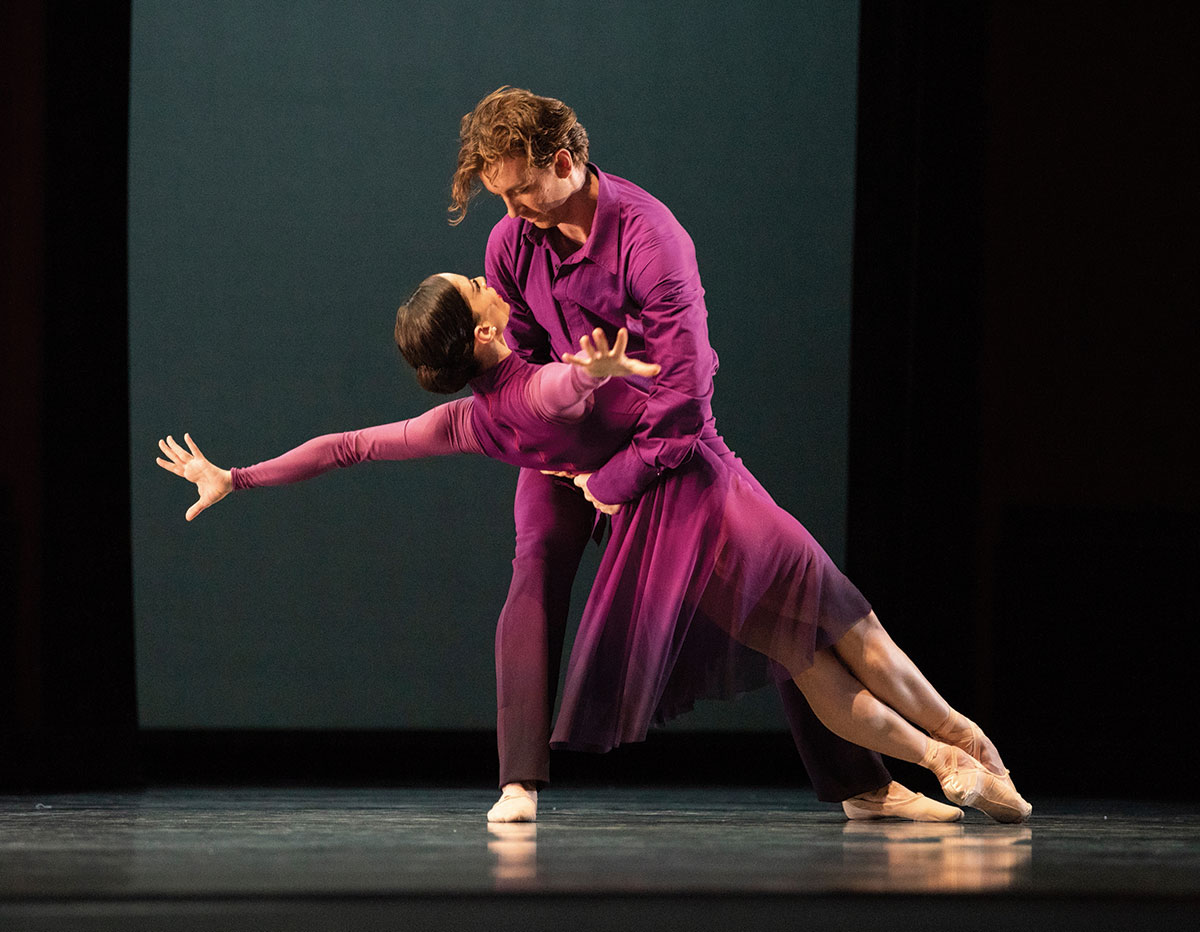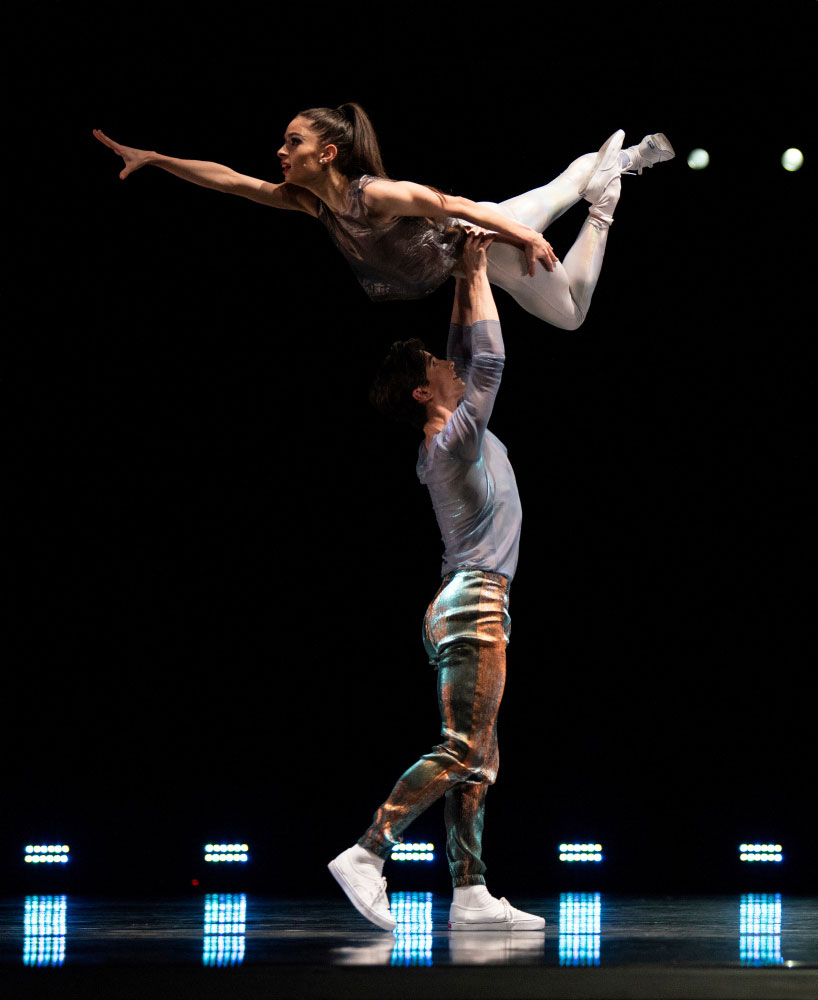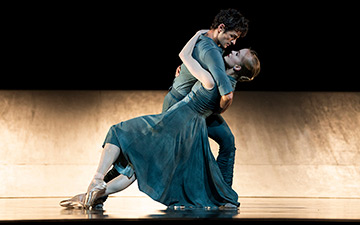
© Erik Tomasson. (Click image for larger version)
San Francisco Ballet
Program 2, Kaleidoscope: Divertimento No. 15, Appassionata, Hurry Up, We’re Dreaming
★★★★✰
San Francisco, War Memorial Opera House
12 February 2019
www.sfballet.org
While I do enjoy full-length narrative works, of which there are three in the San Francisco Ballet (SFB) repertoire this year, for me, the meat of the season is always the mixed repertory programming. It offers a chance to see this company dance a wide swath of choreographic styles, work from multiple choreographers that, depending on the collection, might range from classic to post-modern, abstract to thematic, Dance Theater to pure, distilled movement. The first of these programs launched on Tuesday was a triple bill joining George Balanchine’s Divertimento No. 15, the San Francisco Ballet premiere of Benjamin Millepied’s Appassionata and Justin Peck’s Hurry Up, We’re Dreaming. It was a winning night of choreography and performance.
Helgi Tomasson has a knack of choosing great program openers, and he succeeded once again with Balanchine’s 1956 Divertimento No. 15. A much-lauded abstract suite set to Mozart, Divertimento posits a rich intersection of two genres: neoclassical choreography and music from the classical period. Its union of the pair is indeed potent, with the choreography not only mirroring the shape and tone of the music but also experimenting with the reverse. In this way, Divertimento feels akin to any marriage, abounding with consonance (hopefully) and also experiencing periods of dissonance.

Choreography by George Balanchine © The Balanchine Trust. © Erik Tomasson. (Click image for larger version)
Danced by thirteen women and three men, consonance was reflected during the larger, group sections of the work. With brisk tempos, virtuosic ornaments and plucky staccato notes, the opening allegro and the finale movements were bright and sparkling. Balanchine certainly evoked that same sense in the choreography – crisp batterie, spirited bourées and punctuated phrases erupting in all directions. Stately poses and grand walking aptly characterized the regal andante chapter, as did the phrasing of the steps in the minuet live into the music’s triple meter. As for the opposite, much of Divertimento’s solo work felt in contrast to the music. Which might sound negative, but it’s actually an asset to the piece. Balanchine’s dual exploration – the dance and music in harmony as well as in counterpoint – makes for a layered experience. Slow, lilting melodies were countered with sharp relevés, vigorous sequences and cheeky postures; quiet chord progressions with soaring jumps. Among these solos, standouts included Sasha De Sola’s enviable speed and Mathilde Froustey’s stellar pointework. And I can’t leave the discussion of Divertimento without commenting on the choreographic vocabulary. Not only does the ballet feature some steps that are personal favourites (pas de trois, emboîté turns and the rare front penchée), but its focus on footwork and épaulement instead of sky-high extensions allows elegance and artistry to wash over the stage.

© Erik Tomasson. (Click image for larger version)
The abstract start soon gave way to intense drama with Millepied’s Appassionata, created for the Paris Opera Ballet in 2016. Appassionata strikes with its capacity to surprise. When the ballet opens, its emotional arc seems straightforward. Three couples are introduced, all illustrating different relationships, or different points in a relationship. Elizabeth Powell and Benjamin Freemantle communicated a youthful, exuberant energy; Jaime Garcia Castilla and De Sola a volatile desperation; and Dores André and Ulrik Birkkjaer a distinct plasticity, a connection filled with push and pull, give and take. It felt like a work focusing on these three states was likely to follow. But Appassionata is not a one-note piece, and quickly you realize that it is going to upend your expectations. Just like a kaleidoscope, Millepied begins to turn the dial, forming new pictures and new pairings. Then he does it again. And again. With every new pairing came a layering and broadening of each individual’s emotional identity to the point where eventually the six seem emotionally unrecognizable from the beginning. This was also reinforced by a dramatic costume change from bright-jewelled tones to shades of white, grey and black. Appassionata’s trend of constant change continued a wild abandon brewing until the final blackout. There was just one throughline that didn’t add up. Unless I missed something, all the various pas de deux throughout Appassionata were male/female. Yes, the women spent some time dancing together in unison as did the men, but not as duet partners. It felt like a missed opportunity.

© Erik Tomasson. (Click image for larger version)
The evening closed with Peck’s Hurry Up, We’re Dreaming, the first of several works returning to the repertory from last spring’s Unbound Festival. Hurry Up conjures Jerome Robbins’ many forays into the themes of youth and community. I dearly love those works (Opus Jazz, Glass Pieces), and so, was delighted to see a similar narrative thread play out in Hurry Up. With the wings and back cyclorama removed, the stage became a blank canvas on which anything might emerge. Oozing intention and confidence, the dancers entered the space, faced each other and holding hands, created a giant circle. As one entity, they took a deep breath in preparation for the coming athletic endeavour (which would recur as Hurry Up concluded). Camaraderie and encouragement were everywhere. Linked arms imbued the dance’s various vignettes; joy abounded in turns and leaps. Hands scanned the horizon and the gaze rose up, everyone eager to see what the future may hold. Pedestrian circuits found the cast weaving in and out of each other’s trajectory, their journeys linked and connected. And the design was terrific. Reid Bartelme and Harriet Jung’s costumes channeled the 1980s with metallic fabrics, crop tops and tube socks, and wearing white sneakers, the cast of fourteen danced with a brio to M83’s electronic score. But Hurry Up did encounter some interruptions. Peck opted to infuse the ballet with a number of featured duets, and while each one had some spectacular moments, the energy lagged significantly during these interludes. Hurry Up was about the group and was at its best when the entire group was onstage.
Program 2 runs in tandem with Program 3 until February 23rd.

















You must be logged in to post a comment.